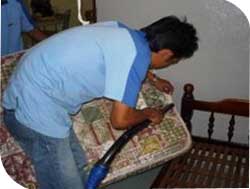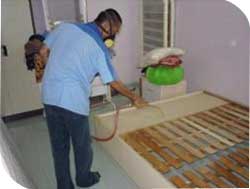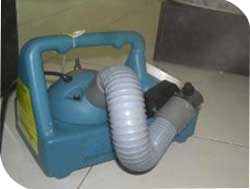Bed Bugs
 Adult bed bugs are brown to reddish-brown, oval-shaped, flattened, and about 3/16 to 1/5 inch long. Their flat shape enables them to readily hide in cracks and crevices. The body becomes more elongate, swollen, and dark red after a blood meal. Bed bugs have a beaklike piercing-sucking mouthpart system Bed bugs do not fly, but can move rapidly over floors, walls, ceilings and other surfaces Female bed bugs lay their eggs in secluded areas, depositing 1, 2 or more eggs per day and hundreds during a lifetime Nymphs can survive months without feeding and the adults for more than a year Bed bugs are active mainly at night. During the daytime, they prefer to hide close to where people sleep Their flattened bodies enable them to fit into tiny crevices — especially those associated with mattresses, box springs, bed frames and headboards Bed bugs usually attack humans, but may feed on other warm-blooded animals, including pets All people are not equally sensitive to bed bug bites, so while some victims break out in rashes from the bites, other people may not display symptoms.
Adult bed bugs are brown to reddish-brown, oval-shaped, flattened, and about 3/16 to 1/5 inch long. Their flat shape enables them to readily hide in cracks and crevices. The body becomes more elongate, swollen, and dark red after a blood meal. Bed bugs have a beaklike piercing-sucking mouthpart system Bed bugs do not fly, but can move rapidly over floors, walls, ceilings and other surfaces Female bed bugs lay their eggs in secluded areas, depositing 1, 2 or more eggs per day and hundreds during a lifetime Nymphs can survive months without feeding and the adults for more than a year Bed bugs are active mainly at night. During the daytime, they prefer to hide close to where people sleep Their flattened bodies enable them to fit into tiny crevices — especially those associated with mattresses, box springs, bed frames and headboards Bed bugs usually attack humans, but may feed on other warm-blooded animals, including pets All people are not equally sensitive to bed bug bites, so while some victims break out in rashes from the bites, other people may not display symptoms.
Bed Bugs Management
Vacuuming

The use of a sealed vacuum during bed bug treatments is useful Models with strong suction and a directed nozzle can be used to help extract some bed bugs hiding in protected crevices and remove the eggs Vacuums can also be useful for picking up individuals when seen and a general vacuuming of floors and other surfaces may pick up bed bugs that have migrated or been dislodged during bed bug treatments Immediately after use, vacuum bags should be removed, sealed in plastic, and discarded to reduce chances of accidentally spreading bed bugs
Residual Spraying

Insecticides may be applied as liquids directly to cracks, crevices, bed frames, baseboards, or similar sites
ULV Misting

Use a space spray to penetrate an infested area Close all outside doors, windows, etc., as tightly as possible. Inside, open or spread everything to allow fumes to penetrate
